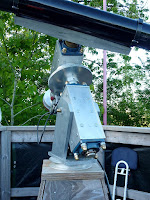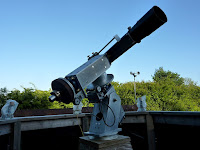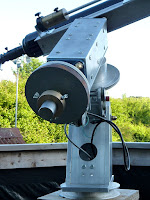*

After a very long day of H-alpha observing I decided to pack everything away as the sun sank behind the local trees. I realised that the mounting details were better seen in this 'flat' light rather than the usual bright sunlight with its blinding highlights and inky shadows.
The construction method of building boxes with 10mm thick, aluminium 'planks' is more easily seen. As are all the heads of the multiple furniture screw. These tension all the internal cross studs which hold all the plates together laterally.
The entire mounting can be reduced to a pile of aluminium plates and components simply by unscrewing all the nuts and studs. There is absolutely no reason why anyone could not copy my design given the materials and will to do so. My original design was strictly dictated by the materials becoming available at the nearest scrap yard. Selection of the least cosmetically challenged surfaces avoided the expense of buying more than I needed. Or, worse, buying new.

The large, 16mm studs, which run lengthwise inside the corners of the bearing boxes are concealed. Except for their large, brass, domed nuts at each end. These large studs and their nuts compress the massive, self aligning, ball bearing, flange bearings onto the ends of the bearing boxes. This denies the plates the ability to slide lengthways. Meanwhile, the smaller, cross studs press against these larger studs. This is for precise location of the bearing boxes' heavy, alloy plates to further stiffen the construction. I like to think of it as a pre-stressed mounting construction.
Upmarket mountings usually apply end loads to their bearings. I haven't bothered with that approach but the large, self-aligning, ball bearing races could easily cope with considerable compression. The 50mm stainless steel axes are a close fit in the bearings so any shake [unwanted freedom] is highly unlikely.
The 11" PA and 8.5" Declination drive wormwheels each have three radial screws with nylon plugs rubbing against the 2" stainless steel main shafts to act as slipping clutches. No movement is required nor desirable to avoid loss of sky location in the drives.The wormwheels had only one screw and plug as supplied. I decided to increase the torque resistance.
AWR's Goto drives are via large stepper motors which I hid in square section alloy tubing for stiffness and physical protection. Early worries about motor overheating were never realised. The motors stay cool even after a full day following the sun in 70F unbroken sunshine. The brass worms are visible and driven by 2:1 toothed belts and pulleys.

The 14' high, plywood clad, pyramidal pier is proving very stable and quickly damps vibration. I was deliberately hitting the pier and mounting support fork with the side of my fist, almost to the point of pain. The Sun's image at 100x merely wobbled slightly and settled quickly again in about one second.

The main PA wormwheel rubs against a 7" diameter cylinder. Which is fixed with multiple stainless steel studs to the Declination axis bearing box.
A Tollok compression/expansion bush is buried tightly inside the cylinder. The Tollok bush clamps itself onto the end of the 50mm [2"] PA shaft. Just as the bush expands strongly against the inside of the cylinder. The cylinder thus acts as a plate bearing to further stiffen the junction of the polar axis with the declination bearing, housing box.

A similar Tollok compression bush is bolted using the 10 fixing/compression screws to the 50cm [30"] long declination saddle. Tollok bushes are often used to carry heavy pulleys and sprockets which drive powerful machines via large electric motors. The exact bush I chose from Tollok's catalogue had the maximum compression sleeve length and largest flange diameter for the 50mm shaft size.

The Tollok bushes are incredibly easy to dismantle. The conical, compression/expansion sleeves are forced apart by removing all 10 normal fixing/clamping screws. Then reinserting several screws into the threaded screw holes provided in the design. Which is incredibly convenient when dismantling the heavy components of the mounting when working alone.
The new OTA balance weights are visible at the top in these images. They help to balance the nose-heavy refractor. A duplicate sliding bar will be added to the other side of the saddle to achieve symmetry of balance. The stainless steel, sliding weight bars are actually hollow with captive nuts in each end. Simple end screw attachment to aluminium angle makes them very user friendly and completely rust free. The large, tubular format ensures a lack of flexure and vibration. They come from the IKEA catalogue at a very modest price indeed.

For scale, the main counterweight is a turned, weight lifter's 5kg [10lb] disk 9" in diameter. The single counterweight is actually too heavy for the mounted, 6" f/8 refractor. So the tube balance weights are thus helping to balance the entire mounting in a dual purpose mode.
I have struggled with balance weights attached directly to OTAs and can confirm they severely limit mobility. Once an 8' long x 8" diameter OTA has passed 30 lbs it becomes a real struggle to carry it out of storage and up the steep stairs to the observing platform. Hence the need for a dome to provide permanent shelter and reduce manhandling large OTAs to an absolute minimum.
The stepper motor drive cables pass through the aperture in the reinforced base fork where the polar altitude adjusting, all stainless steel, turnbuckle is located and concealed. A 16mm cross stud provides the pivot for polar altitude adjustment. Which can then be clamped immovably to further reinforce the PA bearing box and the base fork itself. The fork was designed specifically for my 55N latitude. The 10mm thick front plate is made full height for maximum reinforcement of the fork base.

The PA support, fork blades and its base are constructed from solid plates of 20mm aluminium for maximum stiffness and to avoid corrosion. The fork sits on a thick pulley from the scrap yard. Which helps to spread the mounting loads into the thick, laminated, plywood top of the pier. The pulley also provides smooth rotation for polar alignment when the central 16mm stud is loosened down below, inside the pier. This saves me having to struggle with an inaccessible nut hidden inside the fork.
Click on any image for an enlargement.
*
 A sudden inversion will seriously unbalance the telescope with the potential for considerable damage. I can't even imagine having this lot hanging from a small telescope and mounting! Even without the two low powered eyepieces the entire assembly weighs 3lbs or 1.5kg!
A sudden inversion will seriously unbalance the telescope with the potential for considerable damage. I can't even imagine having this lot hanging from a small telescope and mounting! Even without the two low powered eyepieces the entire assembly weighs 3lbs or 1.5kg! For scale, the main counterweight is a turned, weight lifter's 5kg [10lb] disk 9" in diameter. The single counterweight is actually too heavy for the mounted, 6" f/8 refractor. So the tube balance weights are thus helping to balance the entire mounting in a dual purpose mode.
For scale, the main counterweight is a turned, weight lifter's 5kg [10lb] disk 9" in diameter. The single counterweight is actually too heavy for the mounted, 6" f/8 refractor. So the tube balance weights are thus helping to balance the entire mounting in a dual purpose mode. Wednesday: Further experimentation proved that I could focus the 26mm Plossls in the binoviewer + 1.6x GPC + T-S 1.25" 90° star diagonal. It required that I push the 2" nose of the Etalon adapter directly into the tailpiece. This doesn't make any sense from a geometric point of view where the PST etalon ideally wants to be 200 mm inside focus. I may have to invest in the other 2.6x T-S GPC which claims zero added path length. Though at the expense of increased magnification.
Wednesday: Further experimentation proved that I could focus the 26mm Plossls in the binoviewer + 1.6x GPC + T-S 1.25" 90° star diagonal. It required that I push the 2" nose of the Etalon adapter directly into the tailpiece. This doesn't make any sense from a geometric point of view where the PST etalon ideally wants to be 200 mm inside focus. I may have to invest in the other 2.6x T-S GPC which claims zero added path length. Though at the expense of increased magnification. I could see the whole solar disk but it wasn't as clear as the single 18mm PST Cemax EP. I'm not keen on the Meade 4000 26mm Plossls for binoviewing because of the large eye clearance making it difficult to hold my head still enough at a distance.
I could see the whole solar disk but it wasn't as clear as the single 18mm PST Cemax EP. I'm not keen on the Meade 4000 26mm Plossls for binoviewing because of the large eye clearance making it difficult to hold my head still enough at a distance. I used off-cuts of 2" x 6" x 4" high and cut the bevels to the angles measured with the speed square. The outer ribs required 55° angles which I cut on the vertical on the miter saw. The 2"x 6" block was clamped firmly upright to the back saw fence with a Bessey F-clamp using batten bridges and blocks to avoid accidents. Rather amazingly, the 12" blade could easily manage a 4" deep, vertical cut. Thin packing between the fence and block ensured perpendicularity of the acutely angled cut.
I used off-cuts of 2" x 6" x 4" high and cut the bevels to the angles measured with the speed square. The outer ribs required 55° angles which I cut on the vertical on the miter saw. The 2"x 6" block was clamped firmly upright to the back saw fence with a Bessey F-clamp using batten bridges and blocks to avoid accidents. Rather amazingly, the 12" blade could easily manage a 4" deep, vertical cut. Thin packing between the fence and block ensured perpendicularity of the acutely angled cut.